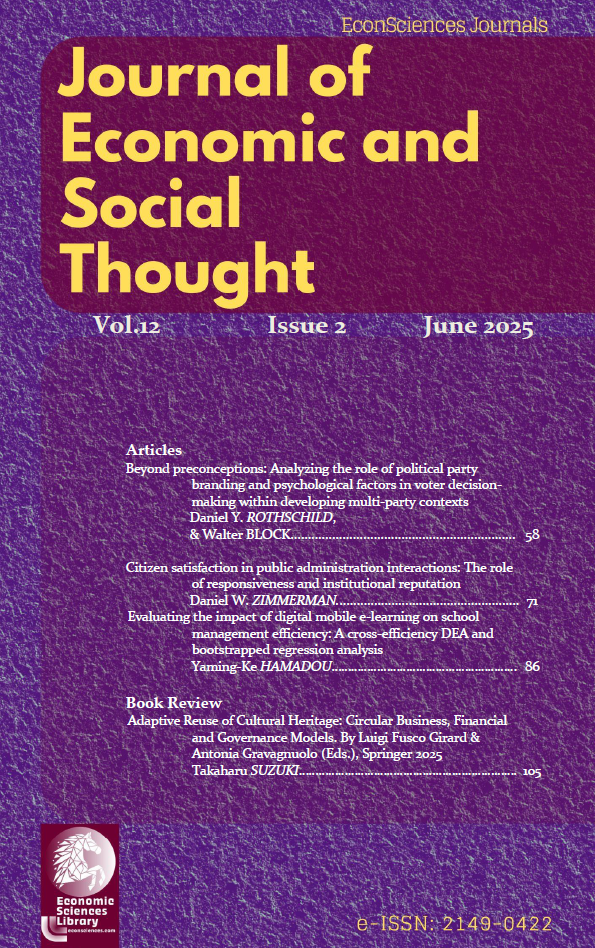Abstract
The interface between citizens and public administration constitutes a domain where frequent and critical direct interactions occur. Yet, the public experience derived from these encounters is remarkably diverse. While a segment of citizens navigates administrative procedures with relative ease and comfort, others report predominantly negative sentiments. Beyond conventional determinants like public trust and general satisfaction with the administration, this study hypothesizes that responsiveness (the speed and relevance of the administration's action) is a significant and crucial factor. Drawing on the analysis of data from representative population surveys, this paper empirically establishes a direct correlation between the perceived responsiveness of the administration and the user's level of satisfaction. Furthermore, the findings indicate that the most substantial explanatory factor for perceived satisfaction with public administration is the established reputation of the specific local public administration entity involved.
Keywords. Public administration; Satisfaction; Responsiveness; Reputation.
JEL. H83; H76; C12.
References
Almond, G. A., & Verba, S. (1963). The civic culture: Political attitudes and democracy in five nations. Princeton University Press.
Behnke, N. (2009). Responsivität und Verantwortlichkeit der öffentlichen Verwaltung. In E. Czerwick, W. H. Lorig, & E. Treutner (Eds.), Die öffentliche Verwaltung in der Demokratie der Bundesrepublik Deutschland (pp. 45-64). VS Verlag. https://doi.org/10.1007/978-3-531-92115-0_3
Blake, R. R., & Mouton, J. S. (1964). The managerial grid. Gulf Publishing Company.
Derlien, H.-U., & Löwenhaupt, S. (1997). Verwaltungskontakte und Institutionenvertrauen. In H. Wollmann, H.-D. Derlien, K. König, W. Renzsch, & W. Seibel (Eds.), Transformation der politisch-administrativen Strukturen in Ostdeutschland (pp. 417-472). Westdeutscher Verlag.
Diamond, L., & Morlino, L. (2005). Assessing the quality of democracy. Johns Hopkins University Press. https://doi.org/10.1007/978-3-322-95838-9_9
Downs, A. (1967). Inside bureaucracy. Little, Brown and Company.
Eulau, H., & Karps, P. D. (1978). The puzzle of representation: Specifying components of responsiveness. In H. Eulau & J. C. Wahlke (Eds.), The politics of representation: Continuities in theory and research (pp. 233-254). Sage Publications.
Feick, J., & Mayntz, R. (1982). Bürger im bürokratischen Staat: Repräsentative Beurteilungen und Handlungseinschätzungen. Die Verwaltung, 15, 409-434.
Giesen-Winkler, U., Margies, B., & Fisch, R. (2011). Integration externen Wissens bei der Einführung einer verständlichen Verwaltungssprache. In R. Schauer, N. Thom, & D. Hilgers (Eds.), Innovative Verwaltungen: Innovationsmanagement als Instrument von Verwaltungsreformen (pp. 177-190). Trauner Verlag.
Grunow, D., & Strüngmann, D. (2008). Bürokratiekritik in der öffentlichen Meinung: Impulse für Verwaltungsreformen. Der Moderne Staat, 1, 121-140.
Hadley, R., & Young, K. (1990). Creating a responsive public service. Harvester Wheatsheaf.
Hirschman, A. O. (1970). Exit, voice, and loyalty: Responses to decline in firms, organizations, and states. Harvard University Press.
Miller, W. E., & Stokes, D. E. (1963). Constituency influence in Congress. American Political Science Review, 57(1), 45-56. https://doi.org/10.2307/1952717
McCubbins, M. D., Noll, R. G., & Weingast, B. R. (1989). Structure and process, politics and policy: Administrative arrangements and the political control of agencies. Virginia Law Review, 75(2), 431-482. https://doi.org/10.2307/1073179
Niskanen, W. A. (1971). Bureaucracy and representative government. Aldine-Atherton.
Powell, G. B. (2004). The chain of responsiveness. Journal of Democracy, 15(4), 91-105. https://doi.org/10.1353/jod.2004.0070
Putnam, R. D. (1993). Making democracy work: Civic traditions in modern Italy. Princeton University Press. https://doi.org/10.1515/9781400820740-fm (= https://doi.org/10.1515/9781400820740)
Rourke, F. E. (1992). Responsiveness and neutral competence in American bureaucracy. Public Administration Review, 52(6), 539-546. https://doi.org/10.2307/977164
Rölle, D. (2010). Schalterdistanz oder bürokratische Kompetenz? Responsivität der öffentlichen Verwaltung in Deutschland. In H. Hill (Ed.), Verwaltungsmodernisierung (pp. 129-148). Nomos-Verlag.
Saltzstein, G. H. (1985). Conceptualizing bureaucratic responsiveness. Administration & Society, 17(3), 283-306. https://doi.org/10.1177/009539978501700303
Saltzstein, G. H. (1992). Bureaucratic responsiveness: Conceptual issues and cultural research. Journal of Public Administration Research and Theory, 2(1), 63-88. https://doi.org/10.1093/oxfordjournals.jpart.a037112
Stewart, J., & Ranson, S. (1994). Management in the public domain. In D. McKevitt & A. Lawton (Eds.), Public Sector Management: Theory, Critique & Practice (pp. 54-70). Sage.
Steiss, A. W., & Daneke, G. A. (1980). Performance administration: Improved responsiveness and effectiveness in public service. Lexington Books.
Stivers, C. (2001). The listening bureaucrat: Responsiveness in public administration. In C. Stivers (Ed.), Democracy, Bureaucracy, and the Study of Administration (pp. 364-369). Westview Press.
Thomas, J. C. (2013). Citizen, customer, partner: Rethinking the place of the public in public management. Public Administration Review, 73(6), 786-796. https://doi.org/10.1111/puar.12109
Vigoda, E. (2000). Are you being served? The responsiveness of public administration to citizens’ demands: An empirical examination in Israel. Public Administration, 78(1), 165-191. https://doi.org/10.1111/1467-9299.00198
Vigoda, E. (2002). From responsiveness to collaboration: Governance, citizens, and the next generation of public administration. Public Administration Review, 62(5), 515-528. https://doi.org/10.1111/1540-6210.00235
Wilson, J. Q. (1967). The bureaucratic problem. The Public Interest, 1, 3-9.
Wood, B. D. (1988). Principals, bureaucrats, and responsiveness in clean-air enforcements. American Political Science Review, 82(1), 213-234. https://doi.org/10.2307/1958066

This work is licensed under a Creative Commons Attribution-NonCommercial 4.0 International License.
